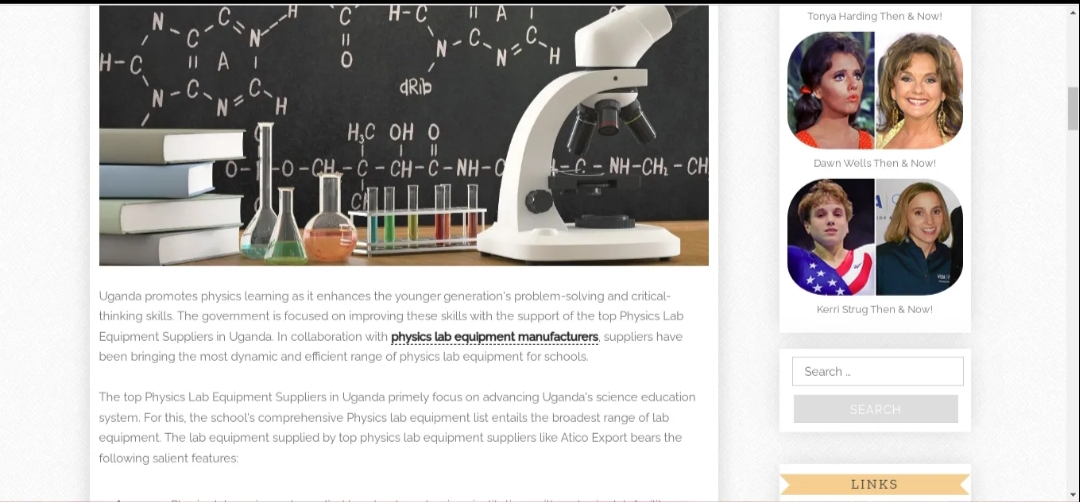Physics laboratories see real action. When equipped with the best-class physics lab equipment, these laboratories serve as dynamic arenas where theoretical concepts transform into tangible realities. And nothing can be a better way to learn and explore physics concepts in a physics lab equipped with much more than the essential lab equipment. Top physics lab equipment manufacturers have everything that brings more than life and zeal to your experiments.
Students working in labs working with the best and most comprehensive range of physics lab equipment get to witness the laws of nature unfold before their eyes. It is the power of physics lab equipment to help conduct experiments that unveil the mysteries of motion, energy, and forces.
The physics laboratory opens the gateways to great breakthroughs and innovation. Physics lab equipment fosters a deep understanding of the universe’s fundamental principles through hands-on engagement and empirical exploration.
Science Lab Supply is the leading physics lab equipment supplier and manufacturer worldwide (especially in Asia & Africa). They supply a wide range of equipment and suggest that every physics lab be equipped with these top 10 physics laboratory equipment.
Equipment Needed In Physics Laboratory
Physics lab equipment listed by the most popular physics lab equipment suppliers is categorized based on their specialized use and the concept of the physics field they contribute to.
An array of instruments is assembled within each laboratory, each chosen for its unique role in investigating specific phenomena. All equipment supplied by suppliers in the physics lab equipment list helps to understand and explore these and many more concepts of physics:
- Newtonian Mechanics:
- Laws of Motion
- Projectile motion
- Conservation of momentum
- Equilibrium
- Optics and Light:
- Reflection and refraction
- Diffraction and interference
- Lens and mirror properties
- Polarization
- Thermodynamics:
- Heat transfer
- Specific heat capacity
- Thermodynamic processes
- Ideal gas laws
- Electricity and Magnetism:
- Ohm’s law and electrical circuits
- Magnetic fields and forces
- Electromagnetic induction
- Capacitance and resistance
- Waves and Vibrations:
- Wave properties (amplitude, frequency, wavelength)
- Standing waves
- Doppler effect
- Sound resonance
- Fluid Mechanics:
- Archimedes’ principle
- Bernoulli’s principle
- Fluid dynamics
- Viscosity
- Atomic and Nuclear Physics:
- Radioactivity and decay
- Particle interactions
- Atomic spectra
- Photoelectric effect
- Quantum Mechanics:
- Wave-particle duality
- Quantum states and probabilities
- Quantum interference
- Special Relativity:
- Time dilation and length contraction
- Relativistic kinematics
- Mass-energy equivalence
- Mechanical Properties of Matter:
- Young’s modulus
- Hooke’s law
- Stress and strain
- Astrophysics:
- Stellar spectroscopy
- Doppler shift in astronomical objects
- Solid State Physics:
- Crystal structure
- Semiconductor properties
- Nanotechnology:
- Nanoscale phenomena and properties
- Environmental Physics:
- Pollution monitoring
- Heat exchange in ecosystems
These and many more physics concepts are explored with physics lab equipment specially designed by physics lab equipment manufacturers. Depending upon the concept in focus, schools can connect with physics lab equipment manufacturers and suppliers for the concerned equipment:
Mechanic
Pulleys and weights
They are among the Top 10 Equipment Needed In Physics Laboratory for the various concepts it clears of physics. Pulleys and weights are commonly used in physics labs to study and demonstrate multiple mechanics-related principles, such as:
- Force and Tension
- Mechanical Advantage
- Newton’s Laws of Motion
- Work and Energy
- Friction
- Torque and Rotational Motion
- Uniform and Non-Uniform Circular Motion
Optics and Light
Mirrors (plane, convex, concave)
Students can learn so much with varied mirrors.Physics lab equipment suppliers supply various kinds of mirrors which help the student understand the following:
Flat Mirrors
- Reflection Laws
- Image Formation
Convex Mirrors
- Diverging Mirrors
- Focal Point and Ray Diagrams
Concave Mirrors:
- Converging Mirrors
- Focal Point and Ray Diagrams
- Mirror Formula and Magnification
Any kind of mirror is crucial in helping students visualize and understand fundamental optics concepts, such as reflection, image formation, focal points, and ray diagrams.
Thermodynamics
Calorimeters
The calorimeter is one of the top 10 essential tools used in a physics lab to understand the physics concept of thermodynamics. It helps to understand the following concepts:
- Heat Transfer Studies
- Specific Heat Capacity
- Calorimetry
- Energy Conservation
- Phase Changes and Latent Heat:
- Specific Applications
- Electricity and Magnetism:
Electricity and Magnetism
Magnetic compasses
Magnetic compasses and magnets serve various purposes in a physics lab, particularly in studying magnetism and electromagnetism. Some of the concepts that it helps the students learn in physics labs are:
- Study of Magnetic Fields
- Verification of Magnetic Poles
- Exploration of Magnetic Forces
- Electromagnetic Induction
- Applications in Electromagnets
Waves and Vibrations:
Ripple Tanks
A water ripple tank is specialized equipment used in physics labs to study and visualize the behaviour of waves, particularly surface waves, in a controlled and observable manner. It helps students visualize the following concepts of physics:
- Wave Propagation Visualization
- Interference and Diffraction
- Reflection and Refraction
Modern Physics
Tesla meter
A tesla meter measures the strength of magnetic fields and helps students understand the following:
- Study & Measurement of Magnetic Field Strength
- Calibration of Magnets and Coils
- Study of Magnetic Materials
- Quality Control and Testing
- Characterization of Electromagnetic Device
Seismograph Model
A seismograph model is valuable physics laboratory equipment
that helps stimulate and study seismic waves, the vibrations propagating through the Earth’s crust during earthquakes or other geological events. It teaches students to learn about the following physics concepts:
- Study of Earthquake Characteristics
- Analysis of Seismograms
- Understanding Earth’s Interior
- Impact of earthquakes
Measurement Instruments
Vernier Caliper
It is a precise measuring instrument used in physics labs for accurate measurements of various objects’ length, thickness, and diameter. Its primary purpose is to provide
- Verification of Theoretical Predictions
- Determination of Uncertainties
- Hands-on Learning and Skill Development
- Engineering and Design Applications
- Calibration and Quality Control
Electrostatic Instruments
Vibration Generator
A vibration generator is specialized equipment in physics labs to produce controlled vibrations or oscillations with adjustable frequencies and amplitudes. It teaches students about the following concepts:
Resonance phenomena
- Harmonic Motion
- Wave Properties and Interference
- Pendulum Studies
- Study Behaviour of structures under dynamic loads
Electricity Laboratory Instruments
Digital pH meter
A digital pH meter measures liquids’ acidity or alkalinity (pH) with high precision. The digital pH meter serves the following purpose in a physics lab:
- Quantitative pH Measurements
- Acid-Base Studies
- Electrochemistry Investigations
- Study Chemical and Physical Equilibria
Educational lab equipment suppliers focus on two aspects: high engagement and effective learning. They offer a superb range of physics lab equipment that ignites a profound appreciation for the world of physics. Budding physicists should get physics lab equipment and gain practical skills to deeply understand the fundamental principles that govern our world.

